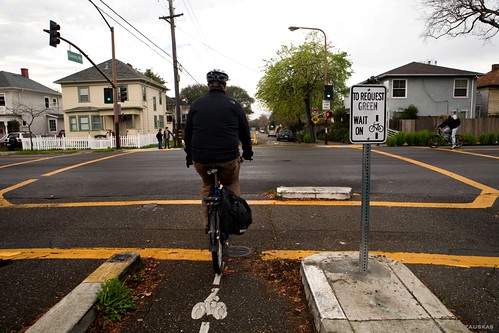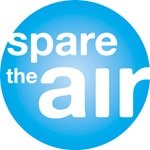 Summer Spare the Air Season is upon us! Get Spare the Air Alerts & other air quality information sent directly to your phone with the iSmog App.
Summer Spare the Air Season is upon us! Get Spare the Air Alerts & other air quality information sent directly to your phone with the iSmog App.
During the summer months, ozone levels in the Bay Area can exceed Federal health-based standards. The Air District’s Spare the Air program issues alerts to let residents know when air quality is expected to be unhealthy. Beyond encouraging people to drive less on high-pollution days, Spare the Air alerts provide critical information for people who suffer from asthma or other respiratory problems.
With 511CC’s free iSmog app for iPhone, you’ll receive Spare the Air alerts and be able to display air quality information for the Bay Area as an easy-to-understand map. Users with allergies or other environmental sensitivities are able to customize air quality notifications based on their level of sensitivity & geographic area.
Download the iSmog app for iPhone, or visit the SpareTheAir.org for more information on how to stay updated on Bay Area air quality.
Tag: BAAQMD
Free Electric Vehicle Test Drives – November 23 & 24, 2015
 If you’re considering purchasing an electric vehicle (EV), visit San Francisco the weekend of November 23 & 24 for an Experience Electric event, where you can test drive EVs from a variety of manufacturers for free.
If you’re considering purchasing an electric vehicle (EV), visit San Francisco the weekend of November 23 & 24 for an Experience Electric event, where you can test drive EVs from a variety of manufacturers for free.
The test-drive weekend is part of a series of Experience Electric events put together by the Metropolitan Transportation Commission (MTC), Bay Area Air Quality Management District (BAAQMD) and Center for Sustainable Energy. The goal of the series is to spur electric vehicle adoption by offering thousands of free test drives around the Bay.
At the event, licensed drivers can test vehicles from a variety of manufacturers free of charge with no sales pressure. Participants should check in at the EV test drive area outside the main entrance of the Moscone Center.
Experience Electric Test-Drive Event
Moscone Center (outside main entrance)
747 Howard Street, San Francisco
Monday & Tuesday, November 23rd & 24th – 10am to 4pm
For more information, check out the MTC press release.
New Bike Racks at Concord's Civic Center (2014)
A half-dozen new bicycle racks were recently installed at Concord Civic Center (1950 Parkside Drive), to accommodate people riding their bicycles to City meetings or to the City offices.
“With more residents using bicycles for transportation as well as fitness, we want to make it as easy as possible for people to ride a bike to Civic Center instead of taking the car,” said project coordinator and Fleet Manager Jeff Roubal. The bicycle racks will also benefit employees who choose to bike to work. The new racks were made possible by a grant from 511 Contra Costa and the Bay Air Quality Management District’s Transportation Fund For Clean Air.
Last year the City of Concord installed new bicycle racks at 15 City parks and facilities. Our handy 511CC bike rack map makes them easy to find and shows the type of rack, maximum number of bikes that can be accommodated, and the location address. The new Civic Center bike racks will soon be added to the City of Concord’s Bicycle Rack map. For more information on the City of Concord’s bicycle parking infrastructure contact Roubal at (925) 671-3147.
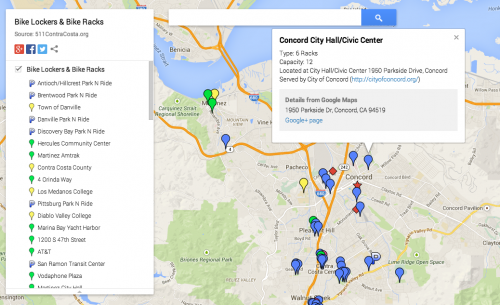
Bay Area Commuter Benefits Program Public Hearing (2014)
WHO: Bay Area Air Quality Management District (BAAQMD)
WHAT: Public hearing to consider the adoption of proposed Regulation 14: Mobile Source Emissions Reduction Measures, Rule 1: Bay Area Commuter Benefits Program. The proposed rule will serve as the foundation for the Bay Area Commuter Benefits Program (Program).
WHEN: Wednesday, March 19, 2014 at 9:45am
WHERE: 939 Ellis Street, San Francisco, CA 94109 at the 7th Floor Board Room
WHY: The objective is to reduce emissions of greenhouse gases (GHGs) and criteria air pollutants by expanding the number of employers who provide commuter benefits to their employees.
Background
California Government Code § 65081 (added by Senate Bill 1339) authorizes BAAQMD and the Metropolitan Transportation Commission (MTC) to jointly adopt and implement a Bay Area commuter benefits ordinance on a pilot basis through 2016.
How it will affect employers
The proposed rule will require employers with 50 or more full-time employees in the Bay Area to select one of the following four commuter benefit options to offer to their employees:
- Allow employees to exclude their transit or vanpool costs from taxable income, up to the maximum amount allowed by current federal law;
- Provide a transit or vanpool subsidy to reduce, or cover, employees’ monthly transit or vanpool costs;
- Provide a low-cost or free shuttle, vanpool, or bus service for employees (operated by or for the employer); or
- Propose an alternative commuter benefit that would be equally as effective as the other options in reducing single-occupant vehicle trips (and/or vehicle emissions).
Employers will also be required to:
- Register through a web-based registration process;
- Designate a contact person;
- Notify employees of the commuter benefit selected and maintain records to document the implementation; and
- Provide information needed for Program evaluation.
What will happen
Should the Air District Board of Directors adopt the proposed rule and if MTC concurs with this action, then Bay Area employers would have six (6) months to comply with the requirements of the program.
Comments
You may submit comments to the proposed rule and supporting documents to commuterbenefits@baaqmd.gov or to
David Burch
Principal Environmental Planner
Bay Area Air Quality Management District
939 Ellis Street
San Francisco, CA 94109
Written comments must be received by 5pm Friday, February 21, 2014.
Proposed Rule and Supporting Documents
See also Bay Area Commuter Benefits Program Public Workshop
See also New Bay Area Commuter Benefit Policy
Bay Area Climate Protection Strategy Workshop (2014)
The Bay Area Air Quality Management District invites you to a workshop on the Clean Air Plan and to initiate development of a Bay Area Climate Protection Strategy.
When: February 28, 2014, 9:30 am – 11:30 am
Where: Air District Office, 939 Ellis Street, San Francisco, 7th Floor
The purpose of the workshop is:
- To kick off the planning process for updating the Clean Air Plan
- To initiate the planning process to develop a Climate Protection Strategy for the Bay Area, which will be included as new element of the Clean Air Plan
- To report progress on implementing the control measures in the 2010 Clean Air Plan
- To solicit ideas and strategies to further reduce ozone precursors (nitrogen oxides, volatile organic compounds), particulate matter, toxic air contaminants, and greenhouse gases
- To seek input on innovative strategies to reduce greenhouse gases, mechanisms for tracking progress in reducing GHGs, and how the Air District may further support actions to reduce GHGs
- To describe future steps and the overall schedule in developing the Clean Air Plan update and Bay Area Climate Protection Strategy
Contact: Christy Riviere at 415-749-4925 or criviere@baaqmd.gov
See the flyer for more information or visit: http://www.baaqmd.gov/Divisions/Planning-and-Research/Plans/Clean-Air-Plan-Update.aspx
The workshop will be webcasted LIVE on the above listed at http://www.baaqmd.gov/Divisions/Planning-and-Research/Plans/Clean-Air-Plan-Update.aspx. Take transit! Civic Center BART station and MUNI lines 47, 49, 38 are nearby. Bike racks located onsite. More transit info at www.511.org.
Need Electronic Bicycle Lockers? Grants now available for Public Agencies (2013)
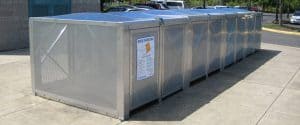 The Bay Area Air Quality Management District (BAAQMD) has announced the availability of $400,000 in Transportation Fund for Clean Air Program (TFCA) Regional Funds for electronic bicycle lockers in the Bay Area. Applications will be accepted until February 10, 2014 and will be reviewed on a first-come, first-served basis. Only public agencies are eligible for this funding.
The Bay Area Air Quality Management District (BAAQMD) has announced the availability of $400,000 in Transportation Fund for Clean Air Program (TFCA) Regional Funds for electronic bicycle lockers in the Bay Area. Applications will be accepted until February 10, 2014 and will be reviewed on a first-come, first-served basis. Only public agencies are eligible for this funding.
See supporting documents, application materials, and a complete listing of eligibility requirements for more information.
Application Webinar – November 21st
An application webinar is scheduled for Thursday, November 21st. This webinar will cover program requirements, application process, and application evaluation criteria. Webinar participation is highly encouraged for all applicants, and mandatory for applicants that have received an audit finding. See webinar schedule and registration details.
For additional information about program eligibility requirements contact Patrick Wenzinger, Administrative Analyst, at (415) 749-4934.
San Francisco Bike Share Is On The Way! (2013)
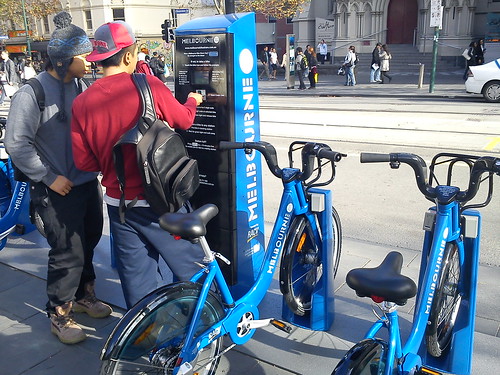
A bike-share dock in Melbourne, Australia. Photo credit: Gavin Anderson
This past month you may have heard about New York City’s historic bike-share launch. New York’s bike-share program continues to incite enthusiasm and excitement, not just for the locals using the system, but for other cities interested in similar bike-share schemes. Here in California one can’t help but to wonder– when will the bike-friendly Bay Area get to enjoy bike-sharing? After all, the Southern Californian city of Anaheim already has bike-sharing (though currently on a very small scale). Well, worry not, bike-sharing could be coming to San Francisco and the Bay Area as early as this summer! The Huffington Post reports:
San Francisco is already one of the most bike-friendly cities in the country, but it’s about to get even more pedal power when the city’s bike sharing program rolls out this August.
Run by the Bay Area Air Quality Management District, in conjunction with the San Francisco Municipal Transportation Agency and other local government groups, the $7 million bike sharing program will be a one- to two-year pilot effort to determine how effective bike sharing is as a method of reducing private automobile traffic and the pollution that comes with it.
The SF bike sharing pilot will be studied for its effectiveness in shifting people out of their cars. It is easy to imagine bike-share being helpful as a means to compliment BART trips and generally help foster multi-modal travel and the replacement for single-occupant vehicle commute trips. The system will start with 700 bikes and 70 bike-share stations but if successful, the pilo could expand to as many as 10,000 bikes throughout the Bay Area (which would make it tied for the largest bike-share system in America).
To get an idea of how bike-share generally operates in North America, check out this video produced for D.C.’s Capital Bike-Share program
Video credit: NACTOfilms
For more details about the Bay Area’s approaching bike-share program, head over to SF.Streetsblog.
New Bay Area Commuter Benefit Policy
With S.B. 1339 passed, are you more likely to pedal as part of your commute?
Photo credit: Carrie Cizauskas
In September 2012, Governor Brown passed into law S.B. 1339 – legislation that allows the Bay Area Air Quality Management District (BAAQMD) and the Metropolitan Transportation Commission (MTC) to implement a region-wide Bay Area commuter policy benefiting employees who work at least 20 hours per week for an employer with 50 or more full-time employees in the nine-county San Francisco Bay Area. The purpose of the legislation is to encourage commuting by means other than single passenger automobile travel.
While some Bay Area cities already have commuter benefit policies to encourage the use of public transit or bicycling, the passage of S.B. 1339 will require select employers to offer one of the following commute benefits:
- The option to pay for transit, vanpooling or bicycling expenses with pre-tax dollars, as allowed by IRS Code 132(f) – the Transportation Fringe Benefit
- A transit or vanpool subsidy of at least $75 per month in 2013 and adjusted annually for inflation thereafter
- Access to a free shuttle or vanpool operated by or for the employer
- A customized alternative program by the employer that provides similar benefits in reducing single-occupant vehicles and is approved by MTC or BAAQMD
Read the S.B 1339 FAQs.
Keep your company connected to the latest S.B. 1339 information by signing up for our newsletter.
Take a Deep Breath– Spare The Air Season Starts!
Tuesday, May 2nd, marked the beginning of Spare the Air season!
But what does this exactly mean?
Summertime is when smog becomes a major health problem here in the Bay and for the past 20 years the Bay Area Air Quality Management District, or BAAQMD, has managed the Spare the Air program to “educate people about air pollution and to encourage them to change their behavior to improve air quality.”

A layer of smog over Los Angeles. Photo credit: G&R
Between now and through October we are all urged to cut back on polluting activities like driving, using aerosol sprays or gas powered lawn mowers. On days where air quality is particularly bad, there will be “Spare the Air” smog alerts issued; those sensitive to unhealthy air are encouraged to limit outdoor time these days.
If you’re the kind of person who likes to breathe healthy air, you needn’t just cut back on activities that cause pollution, you can embrace environmentally friendly ones to help make this a cleaner summer and spare our air!
When it comes to transportation, 511 Contra Costa offers plenty of resources to help change habits for a cleaner air: walking and bicycling, public transit, or carpooling.
You can also download iSmog, an iPhone app that will send push notifications when the air quality in your area is unhealthy. The app allows you to customize when you would like to receive alerts and is free to download.
You can even plan a fantastic vacation while sparing the air thanks to offMetro SF!
If you want to stay informed about local air quality, or get involved to improve conditions, be sure to check out Spare the Air.
Free Webinar June 7, 2012 on Teleworking through the Spare the Air Employer Program

Spare the Air Employer Program invites you to a FREE webinar on Teleworking. Learn how teleworking can eliminate your employees’ commute, reduce emissions and improve your bottom-line!
When: Thursday, June 07, 2012
Time: 10:30 AM – 12 PM (Noon)
Presenter: Elham Shirazi, Telework Expert
Topics covered will include:
- The latest facts on teleworking
- Impact on vehicle miles traveled (VMT) and emissions
- Case studies
- Implementation steps
- How to overcome objections at your workplace
Please RSVP by Friday, June 01, 2012
For more information, contact Stephanie Anderson at sanderson@communityfocus.org or 510.763.2500.

Tomorrow, Tuesday, September 20 and Wednesday, September 30, are Spare the Air days in the San Francisco Bay Area
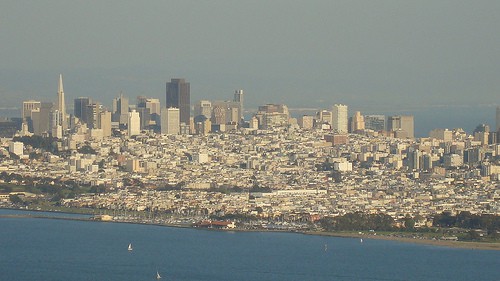
Concentrations of ground-level ozone pollution are forecast to be unhealthy tomorrow, Tuesday September 20th and Wednesday, September 21st. Hot temperatures and light winds will combine to produce poor air quality for the Bay Area.
To help prevent smog, please:
- Pledge to try an alternative or a chance to win – Carpool or vanpool with friends or co-workers
- Take public transportation
- Telecommute — work from home instead of driving to work
- Link necessary trips and avoid/postpone errands if possible
 Visit https://511contracosta.org/ismog/ to download our FREE iSmog application for alert notifications and local air quality forecasts.
Visit https://511contracosta.org/ismog/ to download our FREE iSmog application for alert notifications and local air quality forecasts.
Your air district is offering $4m for projects to help commuters drive less
 The Bay Area Air Quality Management District is now accepting applications from public agencies for shuttle bus and regional ridesharing programs. The District is offering $4 million for these programs. The deadline is September 1. More information here.
The Bay Area Air Quality Management District is now accepting applications from public agencies for shuttle bus and regional ridesharing programs. The District is offering $4 million for these programs. The deadline is September 1. More information here.
That’s all fine and good, but what does all this mean to the rest of us? Continue reading “Your air district is offering $4m for projects to help commuters drive less”
Today, Tuesday June 21, 2011 is a Spare the Air Day

Today is Spare the Air Day. When hot temperature and light winds combine to produce poor air quality for the Bay Area, the Bay Area Air Quality Management District issues a Spare the Air Day alert. To help prevent smog, please consider:
- carpooling or vanpooling
- taking transit
- working from home
- linking errands together
More:
350Green to build network of EV charging stations in Bay Area
 SAN FRANCISCO – 350Green announced its plans yesterday for a national network of electric vehicle (EV) charging stations. Starting with its first project in the San Francisco Bay Area, the company plans to install and operate stations across urban retail shopping centers and other places near where EV drivers live and work. This approach aims to address two of the most vexing challenges facing widespread adoption of EVs: range anxiety and access to a garage for overnight charging.
SAN FRANCISCO – 350Green announced its plans yesterday for a national network of electric vehicle (EV) charging stations. Starting with its first project in the San Francisco Bay Area, the company plans to install and operate stations across urban retail shopping centers and other places near where EV drivers live and work. This approach aims to address two of the most vexing challenges facing widespread adoption of EVs: range anxiety and access to a garage for overnight charging.
“Most of the early focus around EV infrastructure has been on putting charging stations in the home garages of customers, which is great if you have a garage. But since many residents in cities don’t have access to a garage, this effectively limits the number of people who can participate in the EV revolution,” said Mariana Gerzanych, 350Green’s founder and CEO. “Because our public charging stations with fast chargers will be widely and conveniently located near where residents live and work, EV ownership will suddenly become an option for all, regardless of whether they have access to charging in a personal garage.”
The Bay Area project is funded in part by a grant from the Bay Area Air Quality Management District (BAAQMD) as part of its Spare the Air program, which also aims to make owning an electric vehicle in the Bay Area a viable option for residents.
“As part of protecting the air quality in the Bay Area, we’re committed to making electric vehicle technology available to all,” said Jack Broadbent, executive officer of BAAQMD. “Adding to our electric vehicle charging infrastructure will make it easier for Bay Area residents to Spare the Air every day by going electric.”
350Green will build and operate fast charging station plazas in six cities around the area: Albany, Menlo Park, Milbrae, Palo Alto, San Francisco, and Sunnyvale. All of the plazas will be installed in the parking lots of select, high-traffic retail locations, at no cost to the host location.
According to the BAAQMD, the transportation sector accounts for more than 50 percent of air pollution in the Bay Area. Significant emission reductions from the transportation sector will help the Bay Area attain and maintain state and national air quality standards.
Production numbers from EV automakers project approximately one million EVs on US roads by 2015, and possibly 27 million (or 10 percent of all vehicles in the US) by 2020. In the Bay Area, the percentages are even higher: there may be almost 400,000 EVs on the road in the Bay Area by 2020 – or 12 percent of all the area’s vehicles.
350Green will announce specific locations in the coming weeks, and construction, operation and management of its Bay Area network of direct-current (DC) fast chargers and Level 2 chargers will be complete by June 2012. Additional markets around the country in which 350Green will build networks will be determined in collaboration with the company’s city and state partners, as well as stakeholders in the various communities.
Source: 350Green press release, February 1, 2011
Thursday, January 6, 2011 is a Winter Spare the Air Day

Tomorrow, Thursday, January 6, 2011 has been declared a Winter Spare the Air Day for the Bay Area by the Bay Area Air Quality Management District.
To reduce your contribution to air pollution, please consider taking transit, telecommuting.
Wood burning is a major cause of wintertime particulate matter (PM) pollution in the Bay Area. The presence of fine particulate matter in the air is associated with:
- Decreased lung function
- Aggravated asthma
- Nose and throat irritation
- Chronic bronchitis
- Lung damage
- Irregular heart beat
- Premature death in people with lung and heart disease
Continue reading “Thursday, January 6, 2011 is a Winter Spare the Air Day”
Spare the Air Day called for December 12, 2010

Tomorrow, Sunday December 12, 2010 has been declared a Winter Spare the Air Day for the Bay Area by the Bay Area Air Quality Management District. Wood burning is not allowed; second time violators could receive fines of $400.
Please consider reducing your contribution to air pollution by taking transit, ridesharing, and telecommuting.
From baaqmd.gov, here are 10 things you can do to reduce wood smoke pollution:
- Give your fireplace or wood stove the night off.
- Replace your fireplace or wood stove with a clean burning natural gas device.
- Insulate your house to keep warmth in.
- Save energy and reduce pollution by wearing a sweater on chilly nights.
- Switch to an EPA-certified wood burning device or pellet stove, which emit up to 70% less PM.
- Burn clean, hotter fires with plenty of air, in order to prevent visible smoke from a chimney or flue; smoke which indicates poor combustion so adjust dampers or fuel accordingly.
- Never burn, painted wood, treated wood, particle board, plastics, wrapping paper or other garbage; burning them releases toxic chemicals.
- Burn only dry hardwood fuel such as oak or cherry, which produces less smoke and burns hotter; never burn wet wood.
- Store wood in a dry or covered area, off the ground to keep it from getting wet.
- Keep your fireplace and stove well maintained to improve air flow and reduce emissions.
For more information, visit sparetheair.org.
Spare the Air Day called for December 1, 2010

Tomorrow has been declared a Winter Spare the Air Day for the Bay Area by the Bay Area Air Quality Management District. Wood burning is not allowed; second time violators could receive fines of $400.
Please consider reducing your contribution to air pollution by taking transit, ridesharing, and telecommuting.
From baaqmd.gov, here are 10 things you can do to reduce wood smoke pollution:
- Give your fireplace or wood stove the night off.
- Replace your fireplace or wood stove with a clean burning natural gas device.
- Insulate your house to keep warmth in.
- Save energy and reduce pollution by wearing a sweater on chilly nights.
- Switch to an EPA-certified wood burning device or pellet stove, which emit up to 70% less PM.
- Burn clean, hotter fires with plenty of air, in order to prevent visible smoke from a chimney or flue; smoke which indicates poor combustion so adjust dampers or fuel accordingly.
- Never burn, painted wood, treated wood, particle board, plastics, wrapping paper or other garbage; burning them releases toxic chemicals.
- Burn only dry hardwood fuel such as oak or cherry, which produces less smoke and burns hotter; never burn wet wood.
- Store wood in a dry or covered area, off the ground to keep it from getting wet.
- Keep your fireplace and stove well maintained to improve air flow and reduce emissions.
For more information, visit sparetheair.org.
Shadelands Transportation Event-A Huge Success
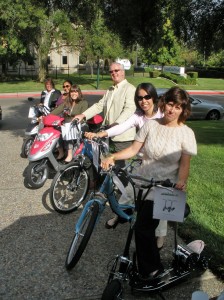
511 Contra Costa hosted a Transportation Event for employees of the Shadelands Business Park last Thursday. The goal of the event was to reach out to all employees within the Shadelands Business Park to promote the various commute options available to them. Nine vendors helped make the event a success. The vendors included 511 Rideshare, Green Wheelin Scooters, BART, County Connection, East Bay Parks, Bay Area Air Quality Management District, Save Mount Diablo, Clipper, and the event organizer 511 Contra Costa. Cupcakes were provided by Kara’s Cupcakes. Council Member Cindy Silva made a brief speech at the event and announced the winner of the certificate for a new bicycle at a local retailer. The Shadelands Transportation Fair was a huge success!
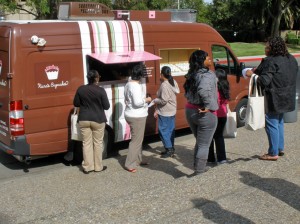

Tuesday, 9/28 is Spare the Air Day

Today is Spare the Air Day in the Bay Area, making it the 4th day in a row the Bay Area Air Quality Management District has issued a smog alert.
If you’ve never tried carpooling, taking transit, or any alternative form of transportation, here’s your chance to earn some rewards. It’s a win-win for you and the environment! Here’s just a sample of what we have to offer those willing to help the cause:
- $60 for carpooling
- 50% off your vanpooling fare
- $64 for trying transit
- 400 hours of free (bike) parking
- Free BART tickets to SFO or OAK
For a full list of ongoing promotions, visit our promos page.
Read more
- Another Spare the Air alert issued for Tuesday – Contra Costa Times
- Bay Area Air Quality Management District
- Spare the Air
Spare the Air alerts Wednesday through Friday, Sept. 1-3, 2010

Wednesday September 1st, is Spare the Air day in the Bay Area, as issued by the Bay Area Air Quality Management District. Update: Thursday, September 2nd and Friday, September 3rd will also have a Spare the Air alerts in effect.
Please consider:
- Taking transit
- Carpooling
- Vanpooling
- Working from home
For more information about air quality, visit our air quality page, download our free iSmog application for iPhone or visit Spare the Air.
Second Spare the Air Day Issued for Bay Area

Today, Tuesday August 24th, is a Spare the Air day in the Bay Area, making today the second smog day issued in two days by the Bay Area Air Quality Management District. On summer Spare the Air days, ground-quality ozone–or smog–levels are expected to be unhealthy and residents are encouraged to cut back on activities that generate pollution. If you are sensitive to unhealthy air, please limit your time outdoors, especially during the afternoon hours.
For more information about air quality, visit our air quality page, download our free iSmog application for iPhone or visit Spare the Air.
Spare the Air Commuter Chronicles Contest – Win a $579 bike or Clipper card loaded with $100

The Bay Area Air Quality Management District is searching for Bay Area residents to share their commuting stories in its Commuter Chronicles video contest. Tell them why and how you Spare the Air during your commute — whether you carpool, take public transit, telecommute, bike or walk to work or get even more creative. Help inform fellow commuters and you just might win:
- * A Dahon Mu Uno Folding Bike ($579 value) *
- * $250 FasTrak pass and $100 Starbucks gift card *
- * One of 10 Clipper passes loaded with $100 *
For your chance to win, record a 60-second or less video showcasing how you help “Spare the Air” and submit it to the Spare the Air YouTube channel.
Continue reading “Spare the Air Commuter Chronicles Contest – Win a $579 bike or Clipper card loaded with $100”
What’s New in the World of Electric Vehicles
As we mentioned earlier this week, the Bay Area will receive $5 million for electric vehicle charging stations as part of the Spare the Air program. This should be welcome news indeed for any current electric vehicle owners or to those considering making the switch. One of the current deterrents to going electric is the fact that a fully charged battery may only withstand short journeys (typically up to 100 miles). More charging stations would provide drivers with more flexibility and help to reduce anxiety- more charging stations would mean that a battery could charge while a driver is at work or out and about fulfilling errands.
The Bay Area Air Quality Management District (BAAQMD)’s approval for funding is just one of many signs that the electric vehicle movement is not far from appealing to a wider audience. President Obama has demonstrated his interest in the subject by not only visiting a Kansas electric manufacturer in July, but also by test driving a Chevy Volt, a new hybrid, a couple of weeks ago. Other companies, such as BMW and Renault, are working to develop sportier and highly durable models, which would show that electric cars will not always be left in the dust of their gas-dependent counterparts.
Soon many more people will have the ability to try out electric vehicles for themselves. Car rental companies, like Enterprise Rent-A-Car and Hertz, will begin offering the Nissan Leaf, a fully electric car, to customers in certain cities early next year.
California based startups are also getting in on the Electric Vehicle, otherwise known as EV, action. California’s Zero Emission Vehicle program allows smaller companies to sell zero emission credits to larger companies. The longer an EV can travel on zero emissions, the more credits it’s worth. One such startup is CODA, which aims to make EVs more readily available and affordable to drivers around the world.
Getting excited yet? We certainly are. If you’d like to learn more about purchasing an EV or a hybrid we highly recommend that you visit DriveClean, which offers a buying guide and tools for measuring smog and global warming scores.
Have you or any of your friends gone electric? If so, please share your experiences with us in the comments!
Bay Area Gets $5 Million for Electric Vehicle Charging Stations
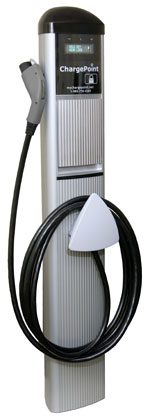 SAN FRANCISCO – Last week, the Bay Area Air Quality Management District (BAAQMD) Board of Directors approved $5 million to support further development of a regional electric vehicle charging infrastructure program in the Bay Area.
SAN FRANCISCO – Last week, the Bay Area Air Quality Management District (BAAQMD) Board of Directors approved $5 million to support further development of a regional electric vehicle charging infrastructure program in the Bay Area.
Today, the Department of Energy announced the program is designed to make electric vehicle ownership a viable option for residents in the Bay Area. The EV charging stations and home chargers are part of BAAQMD’s Spare the Air program.
“The past several years have seen exciting progress in the development of electric vehicle technology,” said Air District Executive Officer Jack P. Broadbent. “Creating a useful charging network will make it easier for Bay Area residents to Spare the Air every day by going electric.”
The Air District is working to support at-home electric vehicle charging and to establish a network of accessible charging sites where electric vehicle owners can conveniently recharge while conducting their normal business, running errands or shopping.
The program will leverage up to $5 million in Air District funds to support electric vehicle charging infrastructure grants including:
- 3,000 home chargers at single family and multi-family dwellings
- 2,000 public chargers at employer and high-density parking areas
- 50 fast chargers within close proximity to highways
In the Bay Area, the transportation sector accounts for more than 50 percent of air pollution. Significant emission reductions from the transportation sector will help the Bay area attain and maintain state and national air quality standards.
The Bay Area Air Quality Management District (www.baaqmd.gov) is the regional agency chartered with protecting air quality in the nine-county Bay Area.
Download the 2010-08-04 BAAQMD News Release
More news on the web:
- Bay Area to install over 5,000 EV charging stations – CNET, August 11, 2010
- San Francisco Bay Area Gets $5 Million for Electric Vehicle Charging Stations – U.S. Department of Energy, August 11, 2010



